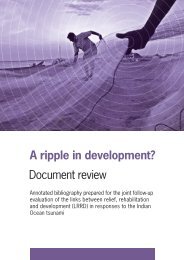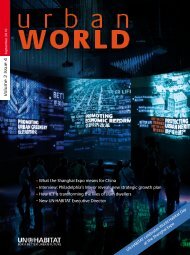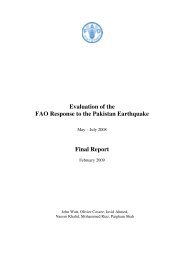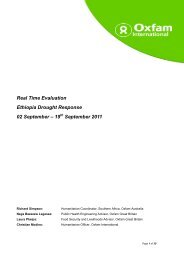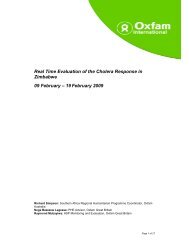Inter-Agency Real Time Evaluation of the Humanitarian ... - alnap
Inter-Agency Real Time Evaluation of the Humanitarian ... - alnap
Inter-Agency Real Time Evaluation of the Humanitarian ... - alnap
Create successful ePaper yourself
Turn your PDF publications into a flip-book with our unique Google optimized e-Paper software.
IA RTE <strong>of</strong> <strong>the</strong> humanitarian response to Pakistan’s 2010 Floods crisis<br />
44. At <strong>the</strong> cluster level, organisations (e.g. WFP, WHO and UNICEF) carried out assessments<br />
related to joint operational frameworks (e.g. <strong>the</strong> survival strategy). The nutrition cluster<br />
succeeded in combining response with assessments (“active case finding” methodology)<br />
enabling <strong>the</strong> cluster partners to identify immediate needs and take proper action. These are<br />
examples <strong>of</strong> cluster‐wide assessments that paved <strong>the</strong> way for what are considered to be positive<br />
responses (see part 6 ‘Response’). They are none<strong>the</strong>less exceptions, as most assessments were<br />
carried out based on single agency operational needs and programming requirements.<br />
45. For different reasons and purposes, INGOs and most UN agencies have carried out<br />
numerous single agency needs assessments. The<br />
main reason being <strong>the</strong> need to have data that is<br />
strictly relevant for organisations’ response<br />
planning, while o<strong>the</strong>rs mentioned that data was not<br />
disaggregated which limits its usefulness in planning<br />
local‐level response activities and that joint<br />
assessments took too long to be carried out; once<br />
<strong>the</strong> results from assessments were ready, <strong>the</strong><br />
situation on <strong>the</strong> ground had already changed. Large<br />
movements <strong>of</strong> populations fur<strong>the</strong>r challenged<br />
assessments, particularly in <strong>the</strong> Sindh province. This<br />
was fur<strong>the</strong>r complicated by <strong>the</strong> lack <strong>of</strong> an initial<br />
registration and pr<strong>of</strong>iling <strong>of</strong> <strong>the</strong> affected population<br />
caseload.<br />
Riccardo Polastro, Aatika Nagrah, Nicolai Steen and Farwa Zafar<br />
We were affected by <strong>the</strong> floods<br />
but we were not asked about<br />
what our needs were. Some<br />
groups visited, but <strong>the</strong>y met with<br />
<strong>the</strong> local feudal landowners only.<br />
These people made promises to<br />
provide us with repair support for<br />
homes, food, tents, and took our<br />
land ownership papers and never<br />
came back (Rahm Ali Shah Village,<br />
Kot Addu)<br />
46. While <strong>the</strong>re is an understanding <strong>of</strong> organisation’s need to have information on needs up<br />
front, <strong>the</strong>re are several drawbacks <strong>of</strong> single agency assessments, one being that too many <strong>of</strong><br />
<strong>the</strong>m are carried out, with <strong>the</strong> result that affected populations are consulted several times, and<br />
are <strong>of</strong>ten left without receiving what is needed or without explanations as to why certain needs<br />
are met while o<strong>the</strong>rs are not.<br />
47. Fur<strong>the</strong>rmore, many <strong>of</strong> <strong>the</strong> assessments used different formats, making information<br />
consolidation a challenging and as yet unresolved task. Information sharing was also<br />
problematic, particularly from agencies and INGOs. This prevented humanitarian partners,<br />
especially OCHA, from getting a more nuanced picture <strong>of</strong> needs across <strong>the</strong> affected areas and<br />
within each <strong>of</strong> <strong>the</strong> clusters. National authorities also complained <strong>of</strong> <strong>the</strong> lack <strong>of</strong> information<br />
sharing, especially at district levels, which prevented <strong>the</strong>m from coordinating efforts more<br />
effectively. A fur<strong>the</strong>r challenge was that data from Government institutions, such as PDMA and<br />
NDMA or line departments, rarely tallied with those put forward by humanitarian partners,<br />
especially <strong>the</strong> MCRAM and <strong>the</strong> DNA. These discrepancies added to <strong>the</strong> confusion at operational<br />
levels.<br />
30







